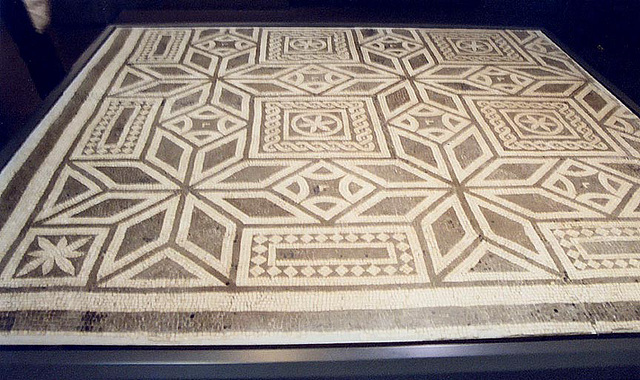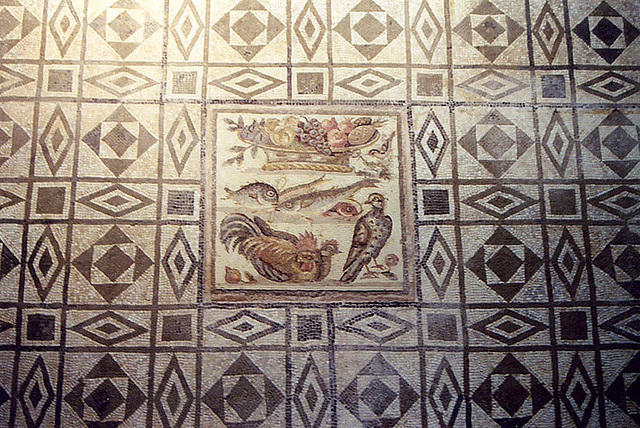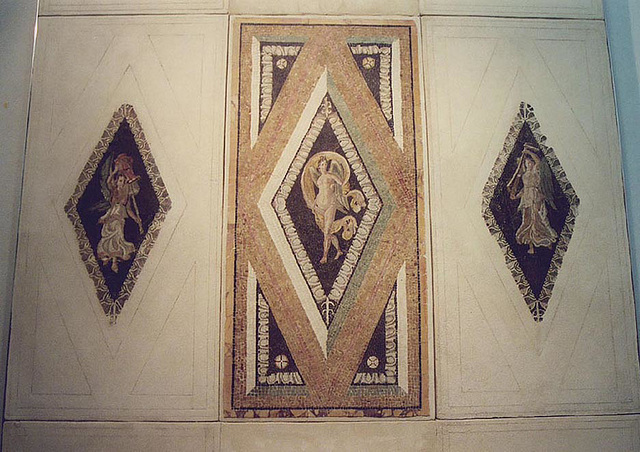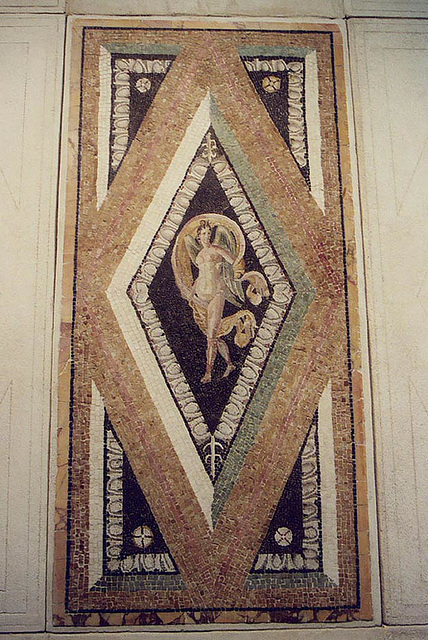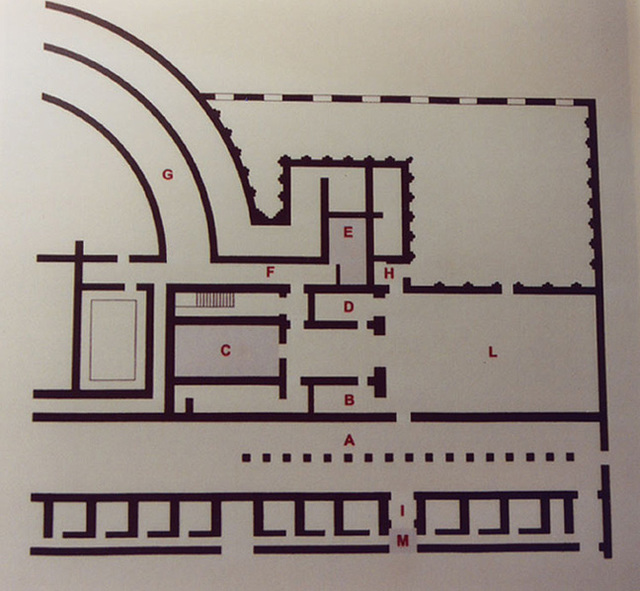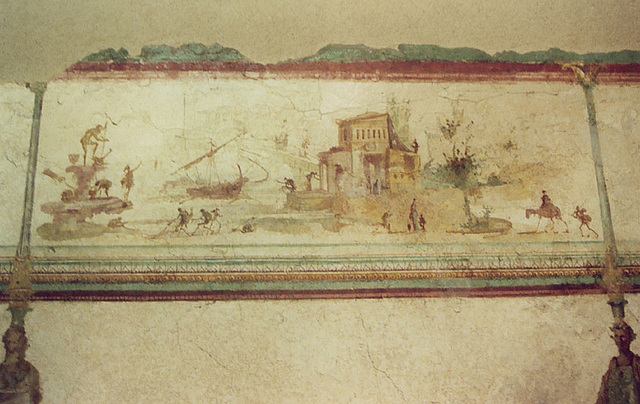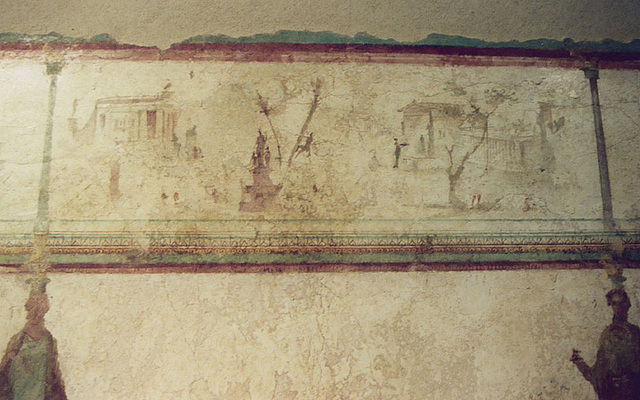
Palazzo Massimo alle Terme
Folder: Italy
Photographs of the Museo Nazionale, "Terme", in Rome, located near Termini train station, and across the street from the Baths of Diocletian.
01 Dec 2003
Black and White Geometric Mosaic in the Palazzo Massimo alle Terme Museum in Rome, Dec. 2003
Palazzo Massimo was built at the end of the nineteenth century as the part of a college. Today it forms part of the National Roman Museum. Exhibits are spread across four floors of the palace. On the ground floor is the Numismatic Section which holds fascinating examples of coinage and monetary systems from their origins in the eighth century B.C. to the introduction of the Euro. Included here are also several gems, jewels and jewellery of the Savoia collection and the section of Oreficeria, most of which served as funerary items. Among these is the mummified "Bambina di Grottarossa", a child found together with its doll. On the other three floors various works of art representing a broad range of classical sculpture are exhibited. These include a statue of Augustus, various Roman copies of Greek statues such as those as the famous "Discobolo Lancellotti", a sleeping Hermaphrodite, Venus about to take a bath, and Apollo which was copied from a fifth century B.C. Greek original in the workshops of Fidia. There is also a section of interesting bronzes. The final floor is dedicated to a wonderful collection of frescoes and mosaics, among them those of the triclinium of the villa of Livia and those of the villa Farnesina. Together these exhibits represent the themes and styles which existed from the first century B.C. to the fourth century A.D. and come from various locations around the city of Rome. Among the most interesting of these is a marbles in laid work representing the Sun God.
Text from: www.italytraveller.com/en/r/rome/c/palazzo-massimo
For more information (in Italian): www.archeorm.arti.beniculturali.it/sar2000/Museo_romano/P...
01 Dec 2003
Geometric Mosaic With a Central Insert in the Palazzo Massimo alle Terme Museum in Rome, Dec. 2003
Palazzo Massimo was built at the end of the nineteenth century as the part of a college. Today it forms part of the National Roman Museum. Exhibits are spread across four floors of the palace. On the ground floor is the Numismatic Section which holds fascinating examples of coinage and monetary systems from their origins in the eighth century B.C. to the introduction of the Euro. Included here are also several gems, jewels and jewellery of the Savoia collection and the section of Oreficeria, most of which served as funerary items. Among these is the mummified "Bambina di Grottarossa", a child found together with its doll. On the other three floors various works of art representing a broad range of classical sculpture are exhibited. These include a statue of Augustus, various Roman copies of Greek statues such as those as the famous "Discobolo Lancellotti", a sleeping Hermaphrodite, Venus about to take a bath, and Apollo which was copied from a fifth century B.C. Greek original in the workshops of Fidia. There is also a section of interesting bronzes. The final floor is dedicated to a wonderful collection of frescoes and mosaics, among them those of the triclinium of the villa of Livia and those of the villa Farnesina. Together these exhibits represent the themes and styles which existed from the first century B.C. to the fourth century A.D. and come from various locations around the city of Rome. Among the most interesting of these is a marbles in laid work representing the Sun God.
Text from: www.italytraveller.com/en/r/rome/c/palazzo-massimo
For more information (in Italian): www.archeorm.arti.beniculturali.it/sar2000/Museo_romano/P...
01 Dec 2003
Mosaic in the Palazzo Massimo alle Terme Museum in Rome, Dec. 2003
Palazzo Massimo was built at the end of the nineteenth century as the part of a college. Today it forms part of the National Roman Museum. Exhibits are spread across four floors of the palace. On the ground floor is the Numismatic Section which holds fascinating examples of coinage and monetary systems from their origins in the eighth century B.C. to the introduction of the Euro. Included here are also several gems, jewels and jewellery of the Savoia collection and the section of Oreficeria, most of which served as funerary items. Among these is the mummified "Bambina di Grottarossa", a child found together with its doll. On the other three floors various works of art representing a broad range of classical sculpture are exhibited. These include a statue of Augustus, various Roman copies of Greek statues such as those as the famous "Discobolo Lancellotti", a sleeping Hermaphrodite, Venus about to take a bath, and Apollo which was copied from a fifth century B.C. Greek original in the workshops of Fidia. There is also a section of interesting bronzes. The final floor is dedicated to a wonderful collection of frescoes and mosaics, among them those of the triclinium of the villa of Livia and those of the villa Farnesina. Together these exhibits represent the themes and styles which existed from the first century B.C. to the fourth century A.D. and come from various locations around the city of Rome. Among the most interesting of these is a marbles in laid work representing the Sun God.
Text from: www.italytraveller.com/en/r/rome/c/palazzo-massimo
For more information (in Italian): www.archeorm.arti.beniculturali.it/sar2000/Museo_romano/P...
01 Dec 2003
Detail of a Mosaic in the Palazzo Massimo alle Terme Museum in Rome, Dec. 2003
Palazzo Massimo was built at the end of the nineteenth century as the part of a college. Today it forms part of the National Roman Museum. Exhibits are spread across four floors of the palace. On the ground floor is the Numismatic Section which holds fascinating examples of coinage and monetary systems from their origins in the eighth century B.C. to the introduction of the Euro. Included here are also several gems, jewels and jewellery of the Savoia collection and the section of Oreficeria, most of which served as funerary items. Among these is the mummified "Bambina di Grottarossa", a child found together with its doll. On the other three floors various works of art representing a broad range of classical sculpture are exhibited. These include a statue of Augustus, various Roman copies of Greek statues such as those as the famous "Discobolo Lancellotti", a sleeping Hermaphrodite, Venus about to take a bath, and Apollo which was copied from a fifth century B.C. Greek original in the workshops of Fidia. There is also a section of interesting bronzes. The final floor is dedicated to a wonderful collection of frescoes and mosaics, among them those of the triclinium of the villa of Livia and those of the villa Farnesina. Together these exhibits represent the themes and styles which existed from the first century B.C. to the fourth century A.D. and come from various locations around the city of Rome. Among the most interesting of these is a marbles in laid work representing the Sun God.
Text from: www.italytraveller.com/en/r/rome/c/palazzo-massimo
For more information (in Italian): www.archeorm.arti.beniculturali.it/sar2000/Museo_romano/P...
01 Dec 2003
Villa Floor Plan in the Palazzo Massimo alle Terme Museum in Rome, Dec. 2003
Palazzo Massimo was built at the end of the nineteenth century as the part of a college. Today it forms part of the National Roman Museum. Exhibits are spread across four floors of the palace. On the ground floor is the Numismatic Section which holds fascinating examples of coinage and monetary systems from their origins in the eighth century B.C. to the introduction of the Euro. Included here are also several gems, jewels and jewellery of the Savoia collection and the section of Oreficeria, most of which served as funerary items. Among these is the mummified "Bambina di Grottarossa", a child found together with its doll. On the other three floors various works of art representing a broad range of classical sculpture are exhibited. These include a statue of Augustus, various Roman copies of Greek statues such as those as the famous "Discobolo Lancellotti", a sleeping Hermaphrodite, Venus about to take a bath, and Apollo which was copied from a fifth century B.C. Greek original in the workshops of Fidia. There is also a section of interesting bronzes. The final floor is dedicated to a wonderful collection of frescoes and mosaics, among them those of the triclinium of the villa of Livia and those of the villa Farnesina. Together these exhibits represent the themes and styles which existed from the first century B.C. to the fourth century A.D. and come from various locations around the city of Rome. Among the most interesting of these is a marbles in laid work representing the Sun God.
Text from: www.italytraveller.com/en/r/rome/c/palazzo-massimo
For more information (in Italian): www.archeorm.arti.beniculturali.it/sar2000/Museo_romano/P...
01 Dec 2003
Red Background Wall Painting in the Palazzo Massimo alle Terme Museum in Rome, Dec. 2003
Palazzo Massimo was built at the end of the nineteenth century as the part of a college. Today it forms part of the National Roman Museum. Exhibits are spread across four floors of the palace. On the ground floor is the Numismatic Section which holds fascinating examples of coinage and monetary systems from their origins in the eighth century B.C. to the introduction of the Euro. Included here are also several gems, jewels and jewellery of the Savoia collection and the section of Oreficeria, most of which served as funerary items. Among these is the mummified "Bambina di Grottarossa", a child found together with its doll. On the other three floors various works of art representing a broad range of classical sculpture are exhibited. These include a statue of Augustus, various Roman copies of Greek statues such as those as the famous "Discobolo Lancellotti", a sleeping Hermaphrodite, Venus about to take a bath, and Apollo which was copied from a fifth century B.C. Greek original in the workshops of Fidia. There is also a section of interesting bronzes. The final floor is dedicated to a wonderful collection of frescoes and mosaics, among them those of the triclinium of the villa of Livia and those of the villa Farnesina. Together these exhibits represent the themes and styles which existed from the first century B.C. to the fourth century A.D. and come from various locations around the city of Rome. Among the most interesting of these is a marbles in laid work representing the Sun God.
Text from: www.italytraveller.com/en/r/rome/c/palazzo-massimo
For more information (in Italian): www.archeorm.arti.beniculturali.it/sar2000/Museo_romano/P...
01 Dec 2003
Urn Wall Painting from Livia's Villa of Prima Porta in the Palazzo Massimo alle Terme Museum in Rome, Dec. 2003
Palazzo Massimo was built at the end of the nineteenth century as the part of a college. Today it forms part of the National Roman Museum. Exhibits are spread across four floors of the palace. On the ground floor is the Numismatic Section which holds fascinating examples of coinage and monetary systems from their origins in the eighth century B.C. to the introduction of the Euro. Included here are also several gems, jewels and jewellery of the Savoia collection and the section of Oreficeria, most of which served as funerary items. Among these is the mummified "Bambina di Grottarossa", a child found together with its doll. On the other three floors various works of art representing a broad range of classical sculpture are exhibited. These include a statue of Augustus, various Roman copies of Greek statues such as those as the famous "Discobolo Lancellotti", a sleeping Hermaphrodite, Venus about to take a bath, and Apollo which was copied from a fifth century B.C. Greek original in the workshops of Fidia. There is also a section of interesting bronzes. The final floor is dedicated to a wonderful collection of frescoes and mosaics, among them those of the triclinium of the villa of Livia and those of the villa Farnesina. Together these exhibits represent the themes and styles which existed from the first century B.C. to the fourth century A.D. and come from various locations around the city of Rome. Among the most interesting of these is a marbles in laid work representing the Sun God.
Text from: www.italytraveller.com/en/r/rome/c/palazzo-massimo
For more information (in Italian): www.archeorm.arti.beniculturali.it/sar2000/Museo_romano/P...
01 Dec 2003
Wall Painting in the Palazzo Massimo alle Terme Museum in Rome, Dec. 2003
Palazzo Massimo was built at the end of the nineteenth century as the part of a college. Today it forms part of the National Roman Museum. Exhibits are spread across four floors of the palace. On the ground floor is the Numismatic Section which holds fascinating examples of coinage and monetary systems from their origins in the eighth century B.C. to the introduction of the Euro. Included here are also several gems, jewels and jewellery of the Savoia collection and the section of Oreficeria, most of which served as funerary items. Among these is the mummified "Bambina di Grottarossa", a child found together with its doll. On the other three floors various works of art representing a broad range of classical sculpture are exhibited. These include a statue of Augustus, various Roman copies of Greek statues such as those as the famous "Discobolo Lancellotti", a sleeping Hermaphrodite, Venus about to take a bath, and Apollo which was copied from a fifth century B.C. Greek original in the workshops of Fidia. There is also a section of interesting bronzes. The final floor is dedicated to a wonderful collection of frescoes and mosaics, among them those of the triclinium of the villa of Livia and those of the villa Farnesina. Together these exhibits represent the themes and styles which existed from the first century B.C. to the fourth century A.D. and come from various locations around the city of Rome. Among the most interesting of these is a marbles in laid work representing the Sun God.
Text from: www.italytraveller.com/en/r/rome/c/palazzo-massimo
For more information (in Italian): www.archeorm.arti.beniculturali.it/sar2000/Museo_romano/P...
01 Dec 2003
Wall Painting in the Palazzo Massimo alle Terme Museum in Rome, Dec. 2003
Palazzo Massimo was built at the end of the nineteenth century as the part of a college. Today it forms part of the National Roman Museum. Exhibits are spread across four floors of the palace. On the ground floor is the Numismatic Section which holds fascinating examples of coinage and monetary systems from their origins in the eighth century B.C. to the introduction of the Euro. Included here are also several gems, jewels and jewellery of the Savoia collection and the section of Oreficeria, most of which served as funerary items. Among these is the mummified "Bambina di Grottarossa", a child found together with its doll. On the other three floors various works of art representing a broad range of classical sculpture are exhibited. These include a statue of Augustus, various Roman copies of Greek statues such as those as the famous "Discobolo Lancellotti", a sleeping Hermaphrodite, Venus about to take a bath, and Apollo which was copied from a fifth century B.C. Greek original in the workshops of Fidia. There is also a section of interesting bronzes. The final floor is dedicated to a wonderful collection of frescoes and mosaics, among them those of the triclinium of the villa of Livia and those of the villa Farnesina. Together these exhibits represent the themes and styles which existed from the first century B.C. to the fourth century A.D. and come from various locations around the city of Rome. Among the most interesting of these is a marbles in laid work representing the Sun God.
Text from: www.italytraveller.com/en/r/rome/c/palazzo-massimo
For more information (in Italian): www.archeorm.arti.beniculturali.it/sar2000/Museo_romano/P...
Jump to top
RSS feed- Latest items - Subscribe to the latest items added to this album
- ipernity © 2007-2025
- Help & Contact
|
Club news
|
About ipernity
|
History |
ipernity Club & Prices |
Guide of good conduct
Donate | Group guidelines | Privacy policy | Terms of use | Statutes | In memoria -
Facebook
Twitter

